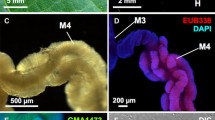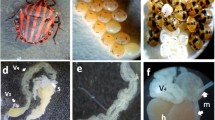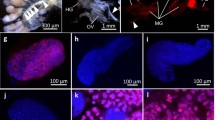Abstract
The cabbage bugs Eurydema rugosa Motschulsky and Eurydema dominulus (Scopoli) (Heteroptera: Pentatomidae: Strachiini) possess a number of crypts in a posterior region of the midgut, which are filled with bacterial symbiont cells. Here we characterized the gut symbionts of Eurydema stinkbugs using molecular phylogenetic and histological techniques. Specific gammaproteobacteria were consistently identified from the posterior midgut of E. rugosa representing nine populations and E. dominulus representing six populations, respectively. The bacterial 16S rRNA gene sequences were identical within the species but slightly different (98.2% sequence identity) between the species. Molecular phylogenetic analysis revealed that the Eurydema symbionts formed a well-defined monophyletic group in the Gammaproteobacteria. The symbionts were phylogenetically distinct from the gut symbionts of the stinkbug families Acanthosomatidae, Plataspidae, Parastrachiidae, Scutelleridae, and other pentatomid species, suggesting multiple evolutionary origins of the gut symbiotic bacteria among diverse stinkbugs. In situ hybridization confirmed that the symbiont is located in the cavity of the midgut crypts. Aposymbiotic insects of E. rugosa, which were produced by egg surface sterilization, were viable but suffered retarded growth, reduced body weight, and abnormal body color, suggesting the biological importance of the symbiont for the host.



Similar content being viewed by others
References
Abe Y, Mishiro K, Takanashi M (1995) Symbiont of brown-winged green bug, Plautia stali Scott. Jpn J Appl Entomol Zool 39:109–115
Bellostas N, Sørensen AD, Sørensen JC, Sørensen H (2007) Genetic variation and metabolism of glucosinolates. Adv Bot Res 45:369–415
Buchner P (1965) Endosymbiosis of animals with plant microorganisms. Interscience, New York
Douglas AE (1998) Nutritional interactions in insect-microbial symbioses: aphids and their symbiotic bacteria Buchnera. Annu Rev Entomol 43:17–37
Folmer O, Black M, Hoeh W, Lutz R, Vrijenhoek R (1994) DNA primers for amplification of mitochondrial cytochrome c oxidase subunit I from diverse metazoan invertebrates. Mol Mar Biol Biotechnol 3:294–299
Fukatsu T, Hosokawa T (2002) Capsule-transmitted gut symbiotic bacterium of the Japanese common plataspid stinkbug, Megacopta punctatissima. Appl Environ Microbiol 68:389–396
Fukatsu T, Nikoh N (1998) Two intracellular symbiotic bacteria from the mulberry psyllid Anomoneura mori (Insecta, Homoptera). Appl Environ Microbiol 64:3599–3606
Galtier N, Gouy M, Gautier C (1996) SEAVIEW and PHYLO_WIN: two graphic tools for sequence alignment and molecular phylogeny. Bioinformatics 12:543–548
Glasgow H (1914) The gastric caeca and the caecal bacteria of the Heteroptera. Biol Bull 3:101–171
Guindon S, Dufayard JF, Lefort V, Anisimova M, Hordijk W, Gascuel O (2010) New algorithms and methods to estimate maximum-likelihood phylogenies: assessing the performance of PhyML 3.0. Syst Biol 59:307–321
Hosokawa T, Kikuchi Y, Meng XY, Fukatsu T (2005) The making of symbiont capsule in the plataspid stinkbug Megacopta punctatissima. FEMS Microbiol Ecol 54:471–477
Hosokawa T, Kikuchi Y, Nikoh N, Shimada M, Fukatsu T (2006) Strict host–symbiont cospeciation and reductive genome evolution in insect gut bacteria. PLoS Biol 4:e337
Kaiwa N, Hosokawa T, Kikuchi Y, Nikoh N, Meng XY, Kimura N, Ito M, Fukatsu T (2010) Primary gut symbiont and secondary Sodalis-allied symbiont in the scutellerid stinkbug Cantao ocellatus. Appl Environ Microbiol 76:3486–3494
Kaiwa N, Hosokawa T, Kikuchi Y, Nikoh N, Meng XY, Kimura N, Ito M, Fukatsu T (2011) Bacterial symbionts of the giant jewel stinkbug Eucorysses grandis (Hemiptera: Scutelleridae). Zool Sci 28:169–174
Kaltenpoth M, Winter SA, Kleinhammer A (2009) Localization and transmission route of Coriobacterium glomerans, the endosymbiont of pyrrhocorid bugs. FEMS Microbiol Ecol 69:373–383
Kikuchi Y (2009) Endosymbiotic bacteria in insects: their diversity and culturability. Microbes Environ 24:195–204
Kikuchi Y, Hosokawa T, Fukatsu T (2007) Insect–microbe mutualism without vertical transmission: a stinkbug acquires beneficial gut symbiont from environment every generation. Appl Environ Microbiol 73:4308–4316
Kikuchi Y, Hosokawa T, Fukatsu T (2008) Diversity of bacterial symbiosis in stinkbugs. In: Dijk TV (ed) Microbial ecology research trends. Nova Science Publishers, Inc, New York, pp 39–63
Kikuchi Y, Hosokawa T, Nikoh N, Meng XY, Kamagata Y, Fukatsu T (2009) Host–symbiont co-speciation and reductive genome evolution in gut symbiotic bacteria of acanthosomatid stinkbugs. BMC Biol 7:2
Kimura M (1980) A simple method for estimating evolutionary rates of base substitutions through comparative studies of nucleotide sequences. J Mol Evol 16:111–120
Nikoh N, Hosokawa T, Oshima K, Hattori M, Fukatsu T (2011) Reductive evolution of bacterial genome in insect gut environment. Genome Biol Evol 3:702–714
Prado SS, Almeida RPP (2009a) Phylogenetic placement of pentatomid stink bug gut symbionts. Curr Microbiol 58:64–69
Prado SS, Almeida RPP (2009b) Role of symbiotic gut bacteria in the development of Acrosternum hilare and Murgantia histrionica. Entomol Exp Appl 132:21–29
Prado SS, Rubinoff D, Almeida RPP (2006) Vertical transmission of a pentatomid caeca-associated symbiont. Ann Entomol Soc Am 99:577–585
Prado SS, Hung KY, Daugherty MP, Almeida RPP (2010) Indirect effects of temperature on stink bug fitness, via maintenance of gut-associated symbionts. Appl Environ Microbiol 76:1261–1266
R Development Core Team (2010) R: A language and environment for statistical computing. R Foundation for Statistical Computing, Vienna. ISBN 3-900051-07-0. http://www.R-project.org
Robinson-Rechavi M, Huchon D (2000) RRTree: relative-rate tests between groups of sequences on a phylogenetic tree. Bioinformatics 16:296–297
Rosenkranz W (1939) Die Symbiose der Pentatomiden. Z Morph Ökol Tiere 36:279–309
Schaefer CW, Panizzi AR (2000) Heteroptera of economic importance. CRC Press, Florida
Shigenobu S, Watanabe H, Hattori M, Sakaki Y, Ishikawa H (2000) Genome sequence of the endocellular bacterial symbiont of aphids Buchnera sp. APS. Nature 407:81–86
Swain T (1977) Secondary compounds as protective agents. Annu Rev Plant Physiol 28:479–501
Swofford DL (2001) PAUP* Version 4.0b10 (computer program). Sinauer, Sunderland
Tada A, Kikuchi Y, Hosokawa T, Musolin DL, Fujisaki K, Fukatsu T (2011) Obligate association with gut bacterial symbiont in Japanese populations of the southern green stinkbug Nezara viridula (Heteroptera: Pentatomidae). Appl Entomol Zool. doi:10.1007/s13355-011-0066-6
Thompson JD, Higgins DG, Gibson TJ (1994) CLUSTAL W: improving the sensitivity of progressive multiple sequence alignment through sequence weighting, position-specific gap penalties and weight matrix choice. Nucleic Acids Res 22:4673–4680
Tomokuni M, Yasunaga T, Takai M, Yamashita I, Kawamura M, Kawasawa T (1993) A field guide to Japanese bugs. Zenkoku Noson Kyoiku Kyoukai, Tokyo
Weirauch C, Schuh RT (2011) Systematics and evolution of Heteroptera: 25 years of progress. Annu Rev Entomol 56:487–510
Acknowledgments
We thank Y. Ayabe, M. Baba, K. Inadomi, S. Kudo, M. Sakakibara, K. Tanaka, A. Tanigawa, and H. Toju for the insect samples. This study was supported by the Program for Promotion of Basic and Applied Researches for Innovations in Bio-oriented Industry (BRAIN) and a Grant-in-Aid for Young Scientists (B) from the Japan Society for the Promotion of Science (JSPS).
Author information
Authors and Affiliations
Corresponding author
Rights and permissions
About this article
Cite this article
Kikuchi, Y., Hosokawa, T., Nikoh, N. et al. Gut symbiotic bacteria in the cabbage bugs Eurydema rugosa and Eurydema dominulus (Heteroptera: Pentatomidae). Appl Entomol Zool 47, 1–8 (2012). https://doi.org/10.1007/s13355-011-0081-7
Received:
Accepted:
Published:
Issue Date:
DOI: https://doi.org/10.1007/s13355-011-0081-7




